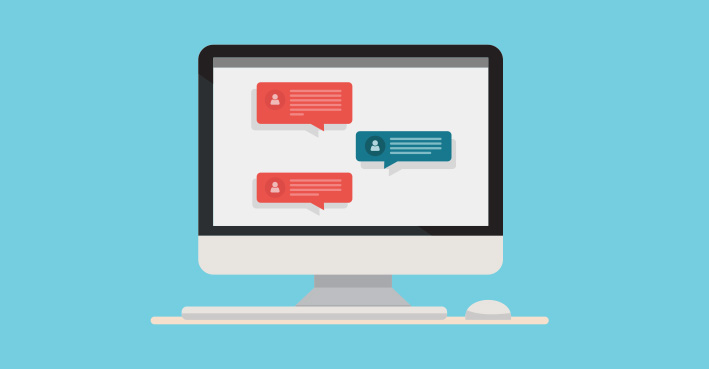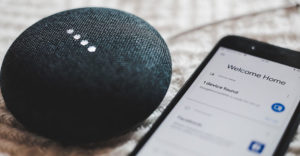How Chatbots Can Help Your Local Service Business

Businesses that don’t use chatbots are quickly falling behind the competition. That’s because consumers are getting more and more accustomed to around-the-clock service. According to HubSpot research, 82% of consumers think an immediate response from brands on marketing or sales questions is “important” or “very important.” In a world of one-hour deliveries, instant information, and on-demand video, reducing service response time is more important than ever. Consumer patience has been conditioned away.
Chatbots are part of the problem, but they’re also part of the solution. Messaging platforms such as Facebook Messenger, WhatsApp, Slack, text messages, and your website can be equipped with chatbot technology to improve customer service, increase conversions, and assist with marketing and sales. Chatbots and virtual assistants allow you to respond to customer inquiries instantaneously at all times. But, the success of your chatbot technology depends on proper planning and execution.
What is a chatbot?

A chatbot is powered by Artificial Intelligence (AI) to automate messages through a chat interface. Chatbot computer programs can be run on nearly any platform that allows messaging between users. For example, you can have a chatbot that automatically respond to Facebook messages, one that assists customers on your website, and another that sends text messages.
Chatbots don’t give you as rich of a conversational experience as Alexa, Siri, or other digital assistants, but they are essentially the same. Using artificial intelligence, chatbots behave like a digital assistant but on a messaging platform instead of voice command. Messaging platforms allow access to their messaging API, but a lot of extra software has to be written by chatbot companies. As the industry grows and advancements in deep learning and Natural Language Processing (NLP) are made, chatbots will get more and more sophisticated.
2 Main Types of Chatbots
There are two main types of chatbots: rule-based chatbots and AI chatbots.
-
Rule-Based Chatbots
 Rule-based chatbots, also known as keyword-recognition or scripted chatbots, can only respond to specific inputs or commands. If the wrong word is used, it might not produce the proper response. A common rule-based chatbot is the FAQbot, which is created from a set of scripted questions and answers.
Rule-based chatbots, also known as keyword-recognition or scripted chatbots, can only respond to specific inputs or commands. If the wrong word is used, it might not produce the proper response. A common rule-based chatbot is the FAQbot, which is created from a set of scripted questions and answers.
For example, if someone were to ask the bot, “What warranty comes with a new HVAC system?”, the bot might analyze the keywords “warranty” and “HVAC system” and answer with a bullet-point list of the parts and labor warranties for different systems offered.
With some simple “broad-match” keywords, rule-based chatbots can immediately serve the most appropriate content users are searching for. Keep in mind that the scripted response might fall short if the bot cannot understand the user’s question or phrasing. You can limit customer frustration with its limitations by setting clear expectations for what the chatbot can assist with. While rule-based bots don’t self-learn, you can observe patterns in conversations to incorporate into new revisions of the bot. Customer-bot interactions can indicate customer pain points and new opportunities for improved service.
Sometimes, all you need is a rule-based chatbot. You don’t need elaborate machine learning to guide users through simple menu choices for example. A button-based chatbot is similar to the phone menu options we dial through to get to the right customer service representative. Many times, rule-based chatbots use menu buttons to get the user to select a question or command that the bot understands, like a flowchart. This bot is sometimes referred to as a hybrid bot, combining menu-based and keyword-based bots.
While rule-based chatbots might use AI technology, each conversation can only follow a set of defined paths. The responses come from a predefined script rather than being shaped over time based on user input and data collection. Rule-based bots are great for customer support functions, answering common queries, and collecting information.
-
AI Chatbots
 AI chatbots, sometimes referred to as contextual chatbots, use Machine Learning (ML) and natural language generation (NLG) and processing (NLP), forms of AI, to effectively respond to questions and commands while continuously self-improving with each interaction. Digital assistants like Alexa and Siri are examples of this type of chatbot. Data is compiled for faster responses, errors can be self-corrected, and favorable responses are noted. They get smarter over time because they learn from every conversation.
AI chatbots, sometimes referred to as contextual chatbots, use Machine Learning (ML) and natural language generation (NLG) and processing (NLP), forms of AI, to effectively respond to questions and commands while continuously self-improving with each interaction. Digital assistants like Alexa and Siri are examples of this type of chatbot. Data is compiled for faster responses, errors can be self-corrected, and favorable responses are noted. They get smarter over time because they learn from every conversation.
According to Ray Kurzweil, “you’ll be able to have a meaningful conversation with an AI in 2029.”
Chatbot Benefits
- Chatbots provide 24/7 customer service availability for a low cost.
- Chatbots are getting better and better at communicating with customers.
- Chatbots increase customer satisfaction (usually).
- Chatbots automate mundane work, such as delivering status updates.
- Chatbot messages have a much higher open and interaction rate than any other form of marketing communication.
How can your business take advantage of chat bots?
Send out communication blasts.
With some chatbots such as MobileMonkey, you can send out a piece of content to members of your Facebook page or group. If they are interested, they can enter their email and get the free piece of content delivered to their email, which grows your email list at the same time.
If a customer agrees to receive push notifications on their device, your message will get sent directly to their phone, much like a text message. You can send your customers everything from reminders and registrations to surveys and special offers. We wish email would function this way, but open rates typically hover around 10%. Chat blasts, on the other hand, have engagement rates around 75% according to SurveyMonkey.
Answer frequently asked questions.
You may have a FAQ page on your website, but it could be difficult to find or read. That’s why many businesses are implementing FAQ answers into chatbots. Let’s say you are browsing a landscaping company’s website and want to know if they repair sprinkler systems. You may be able to search around the website and find the answer, but if there is a live chat box, the customer can simply ask the question there and receive an immediate response.
Using natural language processing and FAQ data, bots can now provide instant assistance day and night. Customers no longer have to wait for an answer. In addition to helping customers find answers faster, FAQ bots also ensure consistent responses and reduce the requests your support team receives.
Get people to fill out forms within the messaging app itself.
Instead of having a long form on your website, chatbots can ask customers one question at a time through a messaging app to collect form data. It’s a more dynamic and engaging way to collect customer information. You can save customer responses to variables and use them elsewhere.
Chatbot software allows to message anyone who has ever sent you a Facebook message.
Segment your audience.
Chatbots make it easy to segment your audience based on conversational criteria. For instance, you can divide your customers up into residential and commercial and send chat blasts only to those customers who have identified themselves in a certain way.
Anticipate the needs of your audience.
Chatbots can be programmed to say different things to different audiences. For instance, if a customer visits a kitchen remodeling page, a bot might spark the conversation by offering them information on the latest remodeling trends.
Provide support in multiple languages.
It might be hard to find a human who knows 7 languages, but bots can speak nearly any language. Many chatbots come with conversational language processing in dozens of languages so you don’t have to worry about losing a customer over a language barrier.
Segment your audience.
Chatbots make it easy to segment your audience based on conversational criteria. For instance, you can divide your customers up into residential and commercial and send chat blasts only to those customers who have identified themselves in a certain way.
Bypass the newsfeed.
The Facebook algorithms have made it harder and harder to get your message to show up organically in front of your followers. What once worked no longer does. That’s just the reality of the marketing world. Facebook now requires you to spend money on ads if you want exposure. Instead of the newsfeed, chatbots can reach customers inside of the Messenger app itself, like getting a message from a friend.
But how do you build up your Messenger list? You can also set up Click-to-Messenger ads, which includes a “Send Message” call to action. If a user clicks on the “Send Message” button, they have opted into Messenger, which allows you to message them later on as many times as you like without continually paying for ads. Keep in mind that they can unsubscribe at any time, like email. But the beauty of it is that the conversation rate is 100%. You pay for each click, but each automatically puts customers into your Messenger list to contact at a later time.
The Rise of the Chatbot
The marketing world is now a 24/7 digital experience. Consumers are using texting and chatting applications in their personal lives so they expect businesses to be able to chat as well. Chatbots can be used on nearly any messaging platform, including text messages and websites. Depending on how they are set up, you can unify conversations from different channels.
Chatbots are a great way to quickly communicate information like status updates and collect customer information, such as a sales or service request. It’s time to start implementing chatbots into your business to aid in your customer service, marketing, and sales goals.
Contact VitalStorm today to learn more about implementing chatbots into your business.

